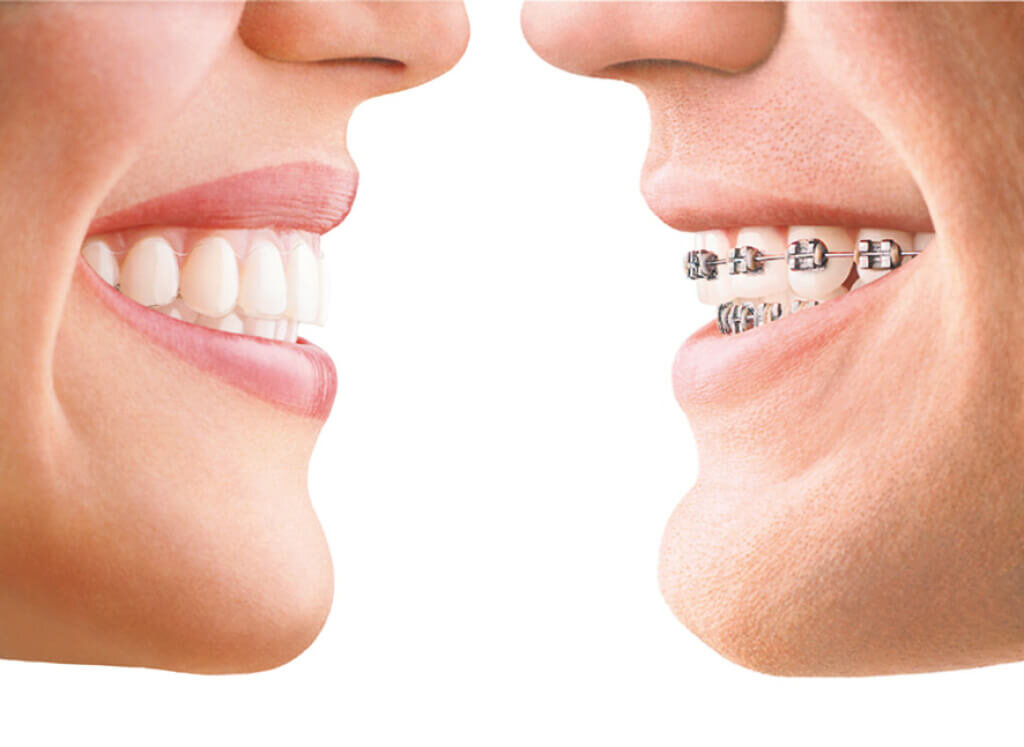The Cost of Invisalign: Understanding the Investment in Your Smile
The Cost of Invisalign: Understanding the Investment in Your Smile
Blog Article
Invisalign vs. Typical Dental braces: Which Option Is Right for You?
When thinking about orthodontic treatment, the choice in between Invisalign and typical dental braces presents several important aspects that warrant mindful evaluation. Invisalign offers a discreet choice with removable aligners, while traditional braces give a more visible yet efficient service for severe misalignment.
Review of Therapy Options

On the other hand, traditional braces contain metal braces and cords that are adhered to the teeth. This method uses constant pressure over time to achieve positioning. While efficient for complicated orthodontic concerns, conventional dental braces call for normal brows through for changes and can position challenges in maintaining dental health as a result of the difficulty of cleaning up about braces and wires.
Both alternatives have their advantages, and the option often hinges on details dental conditions, way of living preferences, and individual compliance. Ultimately, speaking with an orthodontic expert is critical for determining the most appropriate therapy plan customized to private demands. Recognizing the subtleties of each option can significantly affect the total success of orthodontic treatment.
Aesthetic Considerations
A considerable aspect affecting the option in between Invisalign and standard braces is the aesthetic charm each treatment supplies. Invisalign aligners are crafted from clear plastic, making them practically invisible when worn.
In comparison, standard dental braces consist of metal brackets and cables, which can be more recognizable. While advancements in orthodontic modern technology have resulted in the growth of smaller braces and tinted elastics, typical dental braces still preserve a more obvious profile. For some individuals, the presence of dental braces may discourage them from looking for needed treatment.
Ultimately, the choice in between Invisalign and conventional braces may hinge on personal choices relating to looks. Patients that focus on discernment usually favor Invisalign, while those that are much less concerned concerning exposure might choose standard braces. Recognizing the visual implications of each choice is critical for making an educated choice that straightens with one's way of life and preferences.
Convenience and Convenience

In regards to benefit, Invisalign aligners are detachable, allowing patients to enjoy their preferred foods without constraint and preserve optimal oral hygiene. Cleaning and flossing are simplified, as the aligners can be obtained throughout these routines, whereas standard braces need careful navigating around wires and braces.
In addition, Invisalign's dynamic system enables fewer orthodontic check outs. Patients typically get multiple collections of aligners at once, which can enhance the therapy procedure and minimize time spent in the orthodontist's chair. In contrast, typical braces demand normal adjustments, making them much less convenient for those with busy timetables. Invisalign. In general, the convenience and convenience of Invisalign make it an appealing choice for lots of individuals looking for orthodontic treatment.
Treatment Period and Effectiveness
While both Invisalign and standard dental braces work in dealing with oral imbalances, the period of treatment can differ considerably in between both options. Commonly, Invisalign treatment can take anywhere from 12 to 18 months, relying on the intricacy of the situation. The reference clear aligners work by gradually changing next page teeth right into their wanted placements, and routine follow-ups with an orthodontist assistance ensure development stays on the right track.
On the other hand, traditional dental braces commonly need a longer commitment, typically varying from 18 months to 3 years. This is due to their set nature and making use of cords and braces, which can be more efficient for complex situations and severe imbalances (Invisalign). The treatment effectiveness of typical braces is well-documented, as they permit specific adjustments and greater control over tooth movement
Eventually, the selection in between Invisalign and conventional dental braces may depend upon both the awaited treatment period and the particular oral problems available. Consulting with an orthodontist is crucial, as they can supply tailored referrals based on individual needs, ensuring the picked method aligns with preferred timeframes and outcomes.
Price Contrast and Insurance Coverage Alternatives
Expense plays a significant role in the decision-making procedure for people thinking about orthodontic therapy, whether selecting Invisalign or typical braces. Generally, the expense of Invisalign arrays from $3,000 to $8,000, while traditional dental braces usually set you back in between $2,000 and $6,000. Elements influencing these expenses include the intricacy of the instance, the duration of therapy, and geographical location.
Insurance insurance coverage can dramatically influence out-of-pocket expenditures. Numerous dental insurance coverage plans supply partial coverage for orthodontic therapies, however the specifics can vary commonly. It is important for individuals to examine their insurance plan to figure out the level of coverage for either choice. Normally, typical dental braces may be a lot more often covered by insurance coverage strategies compared to Invisalign, which some insurance companies classify as an aesthetic procedure.
In addition, a number of orthodontic practices offer versatile layaway plan, making both treatment choices more easily accessible. Clients need to make inquiries concerning possible financing alternatives and price cuts for ahead of time payments. Reviewing the total price, including insurance coverage benefits and layaway plan, is important for making a notified decision that straightens with both visual choices and budget factors to consider.

Verdict
In summary, the selection between Invisalign and traditional braces depends upon numerous variables, including visual choices, convenience, treatment period, and cost. Invisalign provides a discreet, removable option that promotes oral hygiene and dietary browse around this site flexibility, while standard dental braces might be extra ideal for intricate oral concerns and usually come at a lower price point. Eventually, consultation with an orthodontist is necessary to examine private scenarios and establish the most suitable treatment alternative for attaining optimum oral positioning.
When thinking about orthodontic therapy, the choice in between Invisalign and conventional braces provides a number of vital aspects that merit cautious assessment.Contrasting Invisalign and conventional braces reveals unique treatment choices for orthodontic improvement.While both Invisalign and conventional braces are efficient in fixing dental imbalances, the duration of treatment can vary significantly in between the two alternatives.Price plays a considerable function in the decision-making procedure for individuals thinking about orthodontic treatment, whether deciding for Invisalign or traditional braces.In recap, the choice in between Invisalign and conventional dental braces hinges on multiple factors, including aesthetic choices, convenience, therapy duration, and price.
Report this page